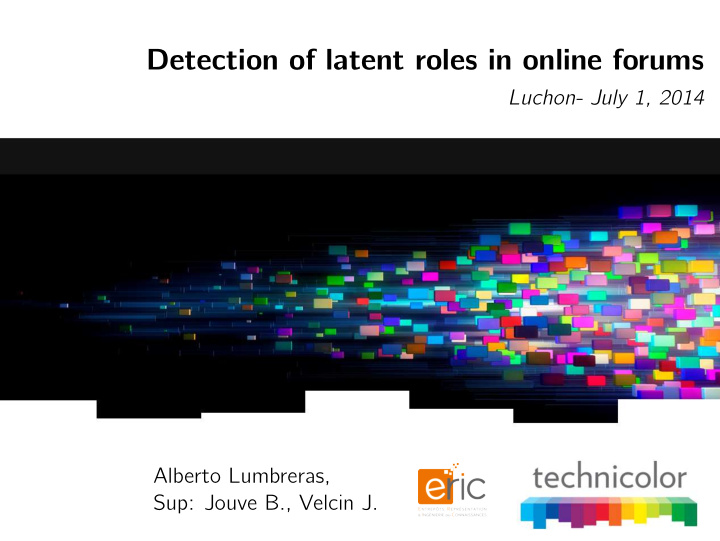



Detection of latent roles in online forums Luchon- July 1, 2014 Alberto Lumbreras, Sup: Jouve B., Velcin J.
Roles in discusion threads Task: detect roles Definition: role as archetypical behavior or social function. 2
Different roles, different definitions. 3
Sociology/Antropology attributes : strategies of speech. technique : ethnology, observational study. Identified roles : Celebrity, Newbie, Lurker, Flamer, Troll, Ranter. [1] S. Golder and J. Donath, “Social roles in electronic communities,” Internet Res., vol. 5, 2004. 4
Similar attributes attributes : in-deg, out-deg, %init, %posts replied, % bi-dir neighs,... technique : clustering. Identified roles : Joining conversationalists, Popular initiators, Taciturns, Supporters, Elitists, Popular participants, Grunts, Ignored. [2] J. Chan, C. Hayes, and E. Daly, “Decomposing discussion forums using common user roles,” in Proceedings of the WebSci10: Extending the Frontiers of Society On-Line, 2010. 5
Similar relationships attributes : sociomatrix (matrix of relations) technique : blockmodeling. Identified roles : Centre-periphery, hierarchies, horizontal structures, ghettos... Figure: Kemp, C., Griffiths, T. & Tenenbaum, J., 2004. Discovering latent classes in relational data. [1] H. White, S. Boorman, and R. Breiger, “Social structure from multiple networks. I. Blockmodels of roles and positions,” Am. J. Sociol., 1976. [2] K. Nowicki and T. A. B. Snijders, “Estimation and prediction for stochastic blockstructures,” J. Am. Stat. Assoc, 2001. 6
Similar relationships Example 7
Role as similar behavior Idea : if you hold role r , you behave like the archetype r plus some noise. b u = r u + ǫ u (1) (toy example) b u ∼ N ( r u , ǫ u ) (2) 8
Intuition 9
Bayesian framework Bayesian probability: joint probability likelihood prior prior likelihood � �� � � �� � � �� � P ( Y , θ ) P ( Y | θ ) P ( θ ) � �� � � �� � P ( θ | Y ) = θ P ( Y , θ ) = θ P ( Y | θ ) P ( θ ) ∝ P ( Y | θ ) P ( θ ) (3) � � � �� � posterior BAYESIAN BONUS : we can make predictions (and therefore validate our model). P ( y | y t − 1 , θ ) (4) 10
Mixture models A generative story: behavior u | role u , θ role ∼ F ( behavior | role u , θ role ) (5) θ role | β ∼ G ( β ) (6) role u ∼ Discrete ( P ( role 1 ) , ..., P ( role K )) (7) P ( role 1 ) , ..., P ( role K ) | α ∼ Dirichlet ( α ) (8) (intuition: imagine F is a Normal distribution, role is the mean µ , and behavior is the observation y ) Probability of everything: � � � P ( b , r , π, θ ) = P ( π | α ) P ( r u | π ) P ( θ r | β ) P ( b u | r u , θ r u ) (9) U K U Marginal probability of r : Intractable: � � � P ( r ) = P ( b , r , π, θ ) (10) π b θ Solution: Gibbs sampling: 1. Loop: (11) r u ∼ P ( r u | r − u , θ, b ) (12) θ k ∼ P ( θ k | θ − k , r , b ) (13) π ∼ P ( π | θ, r , b ) (14) 2. Histogram r u (15) 11
Behaviors Triads in which user is seen. Cascades after user participation. Leskovec et al, “Cascading Behavior in Large Blog Graphs Patterns and a model.” Preference function (patterns of choices). etc. 12
Remarks Mixture models as natural framework to group fuzzy behaviors. Flexibility in what behaviors to study. (structural, text, dynamics...) The main issue: inference (sampling) Machine Learning: Non-parametric model (let the data speak) Efficient sampling methods (parallel, hamiltonian monte carlo...) 13
Thanks! 14
Recommend
More recommend